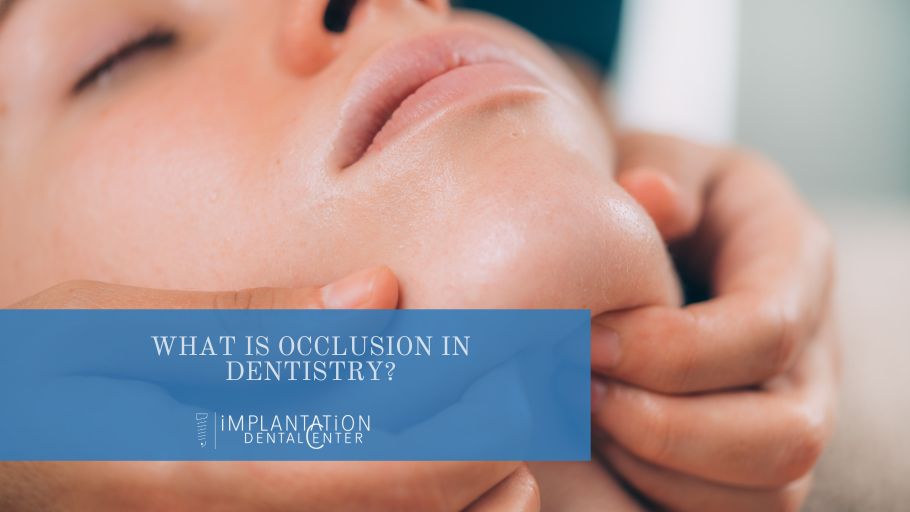In dentistry, occlusion refers to the way your teeth come together when you close your mouth or chew. Dental occlusion can be affected by a number of factors, including the shape and position of your teeth, your jaw size and alignment, and your bite force.
About Occlusion
Occlusion can also refer to the way in which the upper and lower teeth meet when you bite down, which is known as the interdigitation of the teeth. A proper occlusion ensures that the teeth are evenly distributed and that the forces of chewing are properly absorbed by the teeth and supporting structures. Malocclusion, or improper occlusion, can lead to dental problems such as tooth wear, jaw pain, and headaches.
Dentists may use various tools to evaluate occlusion, including articulating paper (thin paper that marks areas of the teeth where contact occurs), wax bite registrations (where the patient bites into wax to record the relationship between the upper and lower teeth), and digital occlusal analysis tools. Based on the evaluation of occlusion, dentists may recommend prosthodontic or orthodontic treatment in order to correct any issues.
Can the wrong bite give me headaches?
Yes, the wrong bite (called malocclusion) can lead to headaches. Malocclusion can cause the jaw muscles to work harder than necessary, leading to muscle tension and pain, which can radiate into the head and cause headaches.
In addition, malocclusion can put excessive stress on the temporomandibular joint (TMJ), the joint that connects the jawbone to the skull. This can cause inflammation, pain, and stiffness in the joint, which can also radiate into the head and cause headaches.
Furthermore, if malocclusion is causing tooth grinding or clenching, this can also contribute to headaches. Grinding or clenching can put pressure on the teeth and the surrounding muscles, leading to tension headaches.
If you are experiencing headaches and suspect that malocclusion may be the cause, it is important to see a prosthodontist who can evaluate your occlusion and recommend appropriate treatment. It might recommend the use of a dental splint to relieve muscle tension and prevent tooth grinding or clenching.
What is the need for an occlusal splint/appliance?
An occlusal splint, also known as a dental splint or night guard, is a removable dental appliance that is used to treat a variety of dental conditions related to the bite and temporomandibular joint (TMJ). The need for an occlusal splint may arise for several reasons, including:
- Bruxism: Bruxism is a condition in which a person grinds or clenches their teeth, often during sleep. This can cause tooth wear, jaw pain, and headaches. An occlusal splint can be used to protect the teeth and reduce the stress on the jaw muscles during grinding or clenching.
- TMJ disorders: TMJ disorders are conditions that affect the temporomandibular joint, which connects the jawbone to the skull. TMJ disorders can cause pain, clicking or popping sounds in the joint, and difficulty opening or closing the mouth. An occlusal splint can be used to stabilize the joint and relieve pressure on the TMJ.
- Bite problems: Malocclusion, or improper bite, can cause tooth wear, jaw pain, and headaches. An occlusal splint can be used to adjust the bite and relieve the stress on the teeth and jaws.
- Dental restorations: Dental restorations such as fillings, crowns, and bridges can change the way the teeth come together, leading to bite problems. An occlusal splint can be used to protect the restorations and stabilize the bite.
Overall, the need for an occlusal splint will depend on the individual patient’s dental condition and symptoms. A prosthodontist can evaluate the patient’s bite and recommend the appropriate treatment, which may include the use of an occlusal splint.
How can a prosthodontist fix the bite?
Prosthodontists are specialists in the restoration and replacement of teeth. They can help fix a bite that is not functioning properly by evaluating the patient’s occlusion and developing a treatment plan to correct any issues.
To fix a bite, prosthodontists may use a combination of restorative and orthodontic treatments. Restorative treatments may include:
- Dental crowns: Crowns can be used to restore the shape, size, and function of teeth that have been damaged or weakened by decay or trauma. Crowns can also be used to change the shape or position of teeth to improve the bite.
- Bridges: Bridges can be used to replace missing teeth and restore the patient’s bite. A bridge consists of two or more crowns that are attached to the teeth on either side of the gap, with an artificial tooth or teeth in between.
- Dentures: Dentures can be used to replace multiple missing teeth and restore the patient’s bite. Dentures can be removable or fixed in place with dental implants.
Orthodontic treatments may include:
- Braces: Braces can be used to straighten crooked teeth and align the bite. Traditional braces consist of metal brackets and wires, but there are also less noticeable options such as ceramic braces or clear aligners.
- Orthodontic appliances: Orthodontic appliances such as headgear, palatal expanders, or bite plates can be used to correct bite problems.
Prosthodontists may also use computer-aided design and manufacturing (CAD/CAM) technology to create precise dental restorations that fit the patient’s bite correctly.
Overall, the specific treatment plan for fixing a bite will depend on the patient’s individual needs and the extent of the bite problem. Prosthodontists can work with patients to develop a personalized treatment plan to improve their bite and restore their oral health.



